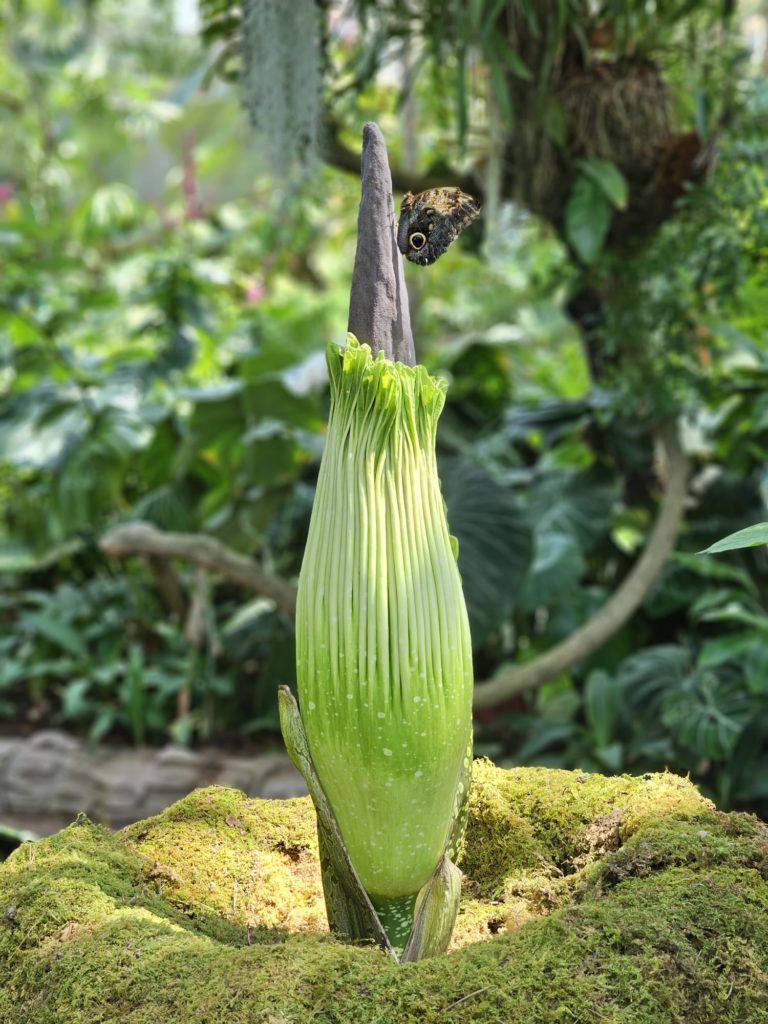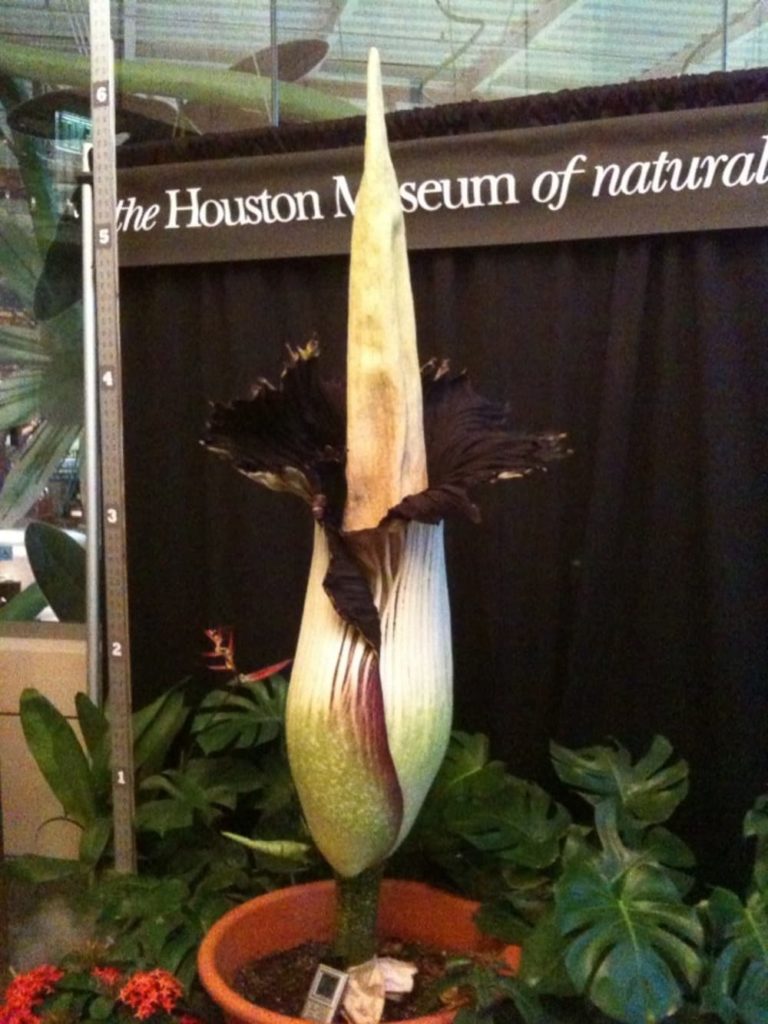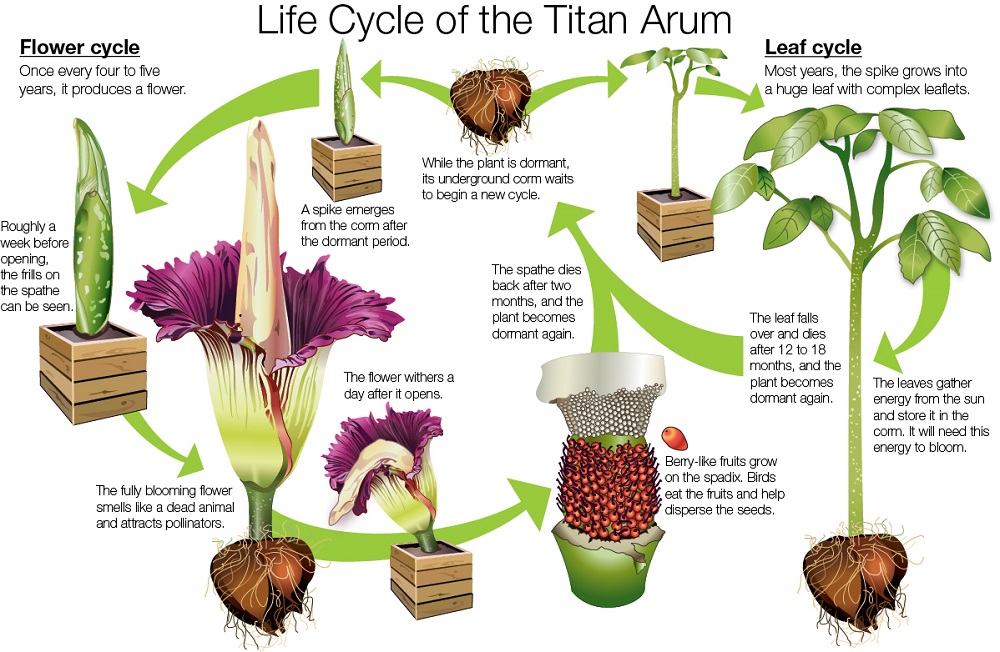The Cockrell Butterfly Center has a plant that’s about to make a big stink! Her name is Meg, named after the prehistoric Megalodon shark featured at the museum’s new SHARKS! exhibit. Meg is an Amorphophallus titanum, also called the Titan Arum but more commonly known as the corpse flower. You might remember our most famous corpse flower of the same species, Lois.

Meg is quite young and this is her first bloom. Every other year she has gone through a leaf stage storing energy in preparation of this event. Rather than a single flower, corpse flowers are actually inflorescence (many flowers). This inflorescence is arranged as a spike known as a spadix. We started measuring Meg when we first noticed that the new growth was indeed a bloom. She has steadily been growing about two inches in height and one inch in circumference every day! We are also recording the temperature of the spadix. There are some indicators to look out for when the bloom will be ready to open- the three bracts at the base of the plant will wither and fall off, the rapid growth will slow down, and the temperature of the spadix will increase. Two or three days after this happens, the bloom should fully open and the whole butterfly center will smell like a dead animal.
In comparison to our original corpse flower, Lois, Meg has a purple spadix while Lois had a yellow one. We also think Meg might be smaller than Lois, but that remains to be seen! In either case, Meg will be a show-stopper for sure when she finally decides to open up.

Amorphophallus titanum is native to the western equatorial rainforests of the island of Sumatra, Indonesia. They tend to grow in limestone hills where they have adapted to thrive in warm, humid, rocky conditions. In the wild, mature corpse flower plants will only bloom about every three years. Because of this, the flowers will not always be in close proximity to each other at the right time for pollination. When in full bloom, the spadix will heat up to disperse its stench for miles.
The spadix contains both male and female flowers and due its stench is mostly pollinated by carrion beetles and flesh flies. The female flowers mature first and are located towards the bottom of the spadix. When the pollinators visit, they are actually looking for a meaty treat to lay their eggs in. When they arrive they deposit pollen on the stigmas of the female flowers. By the time they are ready to fly away the male flowers will release their pollen and the pollinators will carry it to the next flower. The corpse flower will start to collapse about 36 hours after opening and if pollinated will produce bright red fruits along the bottom of the spadix.

This process takes a lot of energy for the plant! The next few years of growth cycles will produce leaves instead of blooms which allow the plant to store energy in their corms, an underground storage organ similar to a bulb or a potato. The corm of the Amorphophallus will produce a single leaf, which at maximum height can resemble a small tree.
The museum greenhouse collection is home to other Amorphophallus species, each with its distinct characteristics and adaptations. From the towering Amorphophallus gigas with its impressive height, to the delicately patterned Amorphophallus paeoniifolius, the genus offers a myriad of unique traits. Many species exhibit stunning leaf shapes, which range from palmate to bipinnate, adding to their aesthetic appeal.
Given their captivating beauty and ecological significance, several Amorphophallus species are subjected to habitat destruction and overexploitation. As a result, conservation efforts are crucial to safeguard their existence. Botanical gardens and research institutions play a vital role in preserving these species by conducting research, maintaining living collections, and engaging in seed banks and propagation programs. Public awareness and education programs further contribute to the protection of these extraordinary plants.
Related Corpse Flower Articles
Lou The Corpse Flower : Why He Smells So Bad And Why We Should Be Excited When He Blooms
My Little Stinky: Corpse Flower Cousin on Display at the Cockrell Butterfly Center






